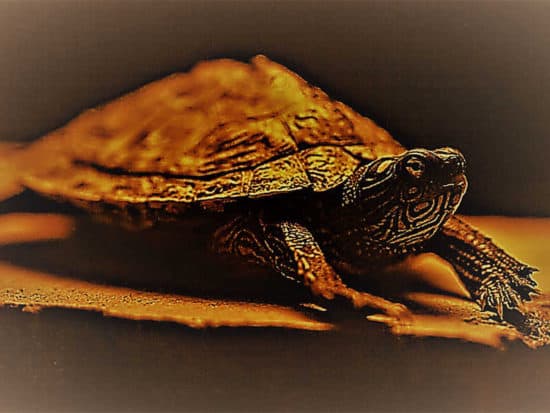When I started keeping turtles years ago, these reptiles were a mystery to me. From their unique behaviors like basking to their diet, there were a lot of things that I did not understand about turtles.
For years, I had been a fish aquarium enthusiast and a dog owner. So, some of the traits, qualities, and habits of a turtle seemed quirky and strange to me.
Even so, it did not curb my enthusiasm to keep turtles. Instead, I became more fascinated, curious, and eager to learn more about these cold-blooded creatures.
Once, I saw something extraordinary and remarkable about my turtles. After turning off the lights, I saw them move as if they had night vision. As a matter of fact, I thought they were more agile and moved better in the dark.
Can turtles see in the dark? I asked myself this question several days later.
See also:
Intrigued, I sought the advice of my fellow pet turtle hobbyists, veterinarians, and scientists. And, soon, I found the answer to this question.
So, can turtles see in the dark? Find out if these creatures can see and move better in the absence of light by reading this guide.
Can Turtles See In The Dark?
Yes, these reptiles see their surroundings when the lights are off. Their vision, though, is not different from a human’s.
When you stay in the dark for a while, your eyes will eventually adjust to the situation. Afterward, the iris will become wide enough to let the tiny amount of light come into your eyes.
This, in turn, allows you to see some things in the dark. And, that is the same way the eyes of a turtle work in the dark.
The truth is, turtles do not have any unique ability like a night vision or infrared to help them see better when the lights are off.
Actually, other reptiles and nocturnal animals, like owls, cats, and geckos, are more likely to see better in the dark.
Humans and most turtles are diurnal creatures, meaning they see better when there is light to help illuminate their surroundings.
So, turtles are not exactly better than humans when it comes to seeing in the dark.
Still, it does not mean turtles see their environment and the world the way we see it.
To get a better understanding of how these reptiles see the world, first, you need to understand how a turtle sees colors.
How These Reptiles See Colors?
For decades, people thought turtles have poor vision. Moreover, a lot of people thought reptiles can’t see and process colors.
But, according to recent studies, turtles not only see colors, but these creatures even see more colors than humans.
Scientific studies confirmed that birds and turtles have the CYP2J19 gene. And guess what? This one-of-a-kind gene can be traced back over 200 million years ago to a strange dinosaur known as Archosaur.
CYP2J19 is also called the red gene since it allows some turtle species and birds to see a ton more red shades than humans do.
While humans see scarlet and crimson, animals with the CYP2J19 perceive an array of red shades in between.

Each animal sees colors since their eyes have color receptors, or also referred to as cones. Human beings have 3 different cone types, and each one detects a specific number of colors that they deliver to the brain.
Then, the brain will process and display the signals sent by the cones.
Turtles, in general, see more colors than people, so it is likely that they also have more types of color receptors.
How Turtles See In The Absence Of Light?
As I have said above, turtles can see in the dark, just like humans do. The only difference is that turtles see colors a bit differently.
In the dark, we do not instantly see everything around us. It, for the most part, takes about 30 minutes for your eyes to totally adjust to the absence of light.
But, after spending some time in the dark, your eye will begin to see some things again.
That is just what happens to turtles too in the dark.
They, however, likely see a more red hue than us when there is no light.
Why Do Other Animals See Better In The Dark?
Animals that can see clearly in the absence of the light, use their tapetum lucidum as their night vision.
And, the tapetum lucidum is a type of reflector located behind the eye’s retina. There are certain creatures blessed with this receptor, including dogs.
Unfortunately, turtles do not have the tapetum lucidum, meaning they do not have night vision.
Do not believe me? Want to prove my theory? Here is a tip. Take a picture of a dog at night with your flashlight turned on. You may also shine some light into the eyes of your dog.
You will likely see a pair of glowing dog eyes.
Repeat the same process again, but this time, with your turtle.
Spoiler alert: your turtle’s eye will not sparkle or glow.
This little experiment shows that these reptiles do not have this special reception.
How Turtles See Perfectly Underwater?
Most turtles, especially sea turtles, spend a great deal of time in the water. So, how do these creatures see clearly underwater?
A turtle’s vision does not change when submerged underwater. They see things the same way, like they are on land, as they swim in the water.
They have the same clarity, and they see the same corresponding colors in the water. Truthfully, only dirty water and debris can impede their vision when they are swimming.
Humans, on the other hand, will have difficulty seeing underwater. Even if you can see a bit when swimming underwater, you definitely cannot do it for a long time. Plus, you cannot see long distances when you are below the water surface.
So, if human eyes and turtle eyes are practically the same, why can they see below the water surface better?
Turtles live in the water and have adapted to their environment’s conditions. Unlike humans, turtles produce liquid or tears that practically cover their own eyes.
These turtle tears prevent their eyes from being affected by the bacteria or salt in the water. Furthermore, this fluid substance covers their eyes, allowing them to see underwater without any issue.
You will love the tips and shared in this in-depth Youtube video!
Facts You Should Know Before Adopting A Pet Turtle
Planning to adopt a turtle as your pet? Here are some things you should before you keep a turtle.
Veggies Are Crucial To Their Eyesight And Health
Every turtle needs a lot of Vitamin A in its diet since it does not store this nutrient in its body. If turtles do not consume adequate amounts of Vitamin A, turtles will soon develop swollen eyelids, which can hinder their vision.
Excellent Vitamin A sources for turtles include yellow, orange, or red vegetables.
A Female Turtle Can Lay Eggs Even Without A Male
Females are, in a way, similar to chickens. They can lay eggs even if there is no male around to help fertilize them. These eggs, however, are infertile and will not hatch.
Most turtles in the wild lay eggs during springtime in response to the light and temperature cycle changes.
That is why you see tons of wild turtles outside on the roads during the warmer months.
Pet turtles, on the other hand, may lay their eggs year-round and do not have seasonal rules.
Keep in mind that their dens or aquariums have controlled temperatures to make sure that they are comfortable in their own environment.
Turtles Live Long
Pet turtles, when fed and housed properly, can live for a few decades. In fact, some of them outlive their owners and are passed to the next generation. Their longevity is something that you, as a potential owner, should consider before you bring a turtle into your home.
Turtles And Reptiles Carry Salmonella
Salmonella is a type of bacteria that turtles and reptiles typically carry in their intestinal tracts. Unlike humans and mammals, turtles and reptiles are not affected by this bacteria.
Turtles shed salmonella intermittently in their stool. That is why it is highly essential to wash your hands carefully after handling their waste.
Not All Turtle Can Swim
Some turtle breeds, like the many box turtle species, need water access to remain hydrated but spend mostly living on dry lands.
You Can Tell The Gender Of A Turtle
In most exotic pets, it is not easy to know whether it is male or female. But, surprisingly, you can easily do that in turtles.
One of the best ways to know a turtle’s gender is to check the length of its tail. Males typically have longer tails, and their vent (rectal opening) is further down than the length of the tail as compared to females.
The vent, in females, is so much closer to their shell. Also, some female turtles have shorter nails than their male counterparts.
They Need A Big Space
Turtle tanks must be at least 5 times the length of one adult turtle and should contain water that is 2 and ½ times as deep as the turtle’s length.
The bigger the turtle species, the bigger its container, and the higher the water volume needed. Also, a powerful filter is required to keep the tank water clean.
Aquatic Turtles Need Dry Land
Pet aquatic turtles, for the most part, live in rectangular aquariums filled with water since they spend a lot of time swimming. Even so, they need some dry land where they can dry off.
Additionally, all turtles need a basking area (usually a large rock) inside their tanks. A basking area is where turtles climb up, hang out and absorb some UVB light.
They Eat Rocks
Turtles love to consume rocks, so ensure all the rocks in its den, including the gravel in the tank bottom, are larger than the head of your turtle, to avoid inadvertent snacking. Take note that rocks can lead to gastrointestinal tract obstruction for turtles.
Discover more fascinating facts about pet turtles by watching this video!
FAQs
Is there something you want to clarify? Then, make sure to check out this article’s FAQ section.
Conclusion
There is more to turtles than their extraordinary vision and eyes. As you keep one as your pet, you will eventually discover a heap of interesting things about these reptiles.
Not only are they charming and wondrously quirky, but they also live longer than other types of pets.
Just do not forget to feed them properly and create a safe haven for your turtles. Ciao!








